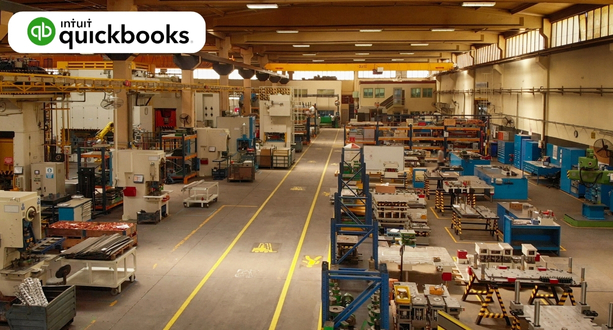Introduction
The Symphony of Success: Mastering Your Manufacturing Melody with QuickBooks
In the vibrant orchestra of manufacturing, where gears whir and pistons pump, every raw material hums a potential melody and every finished product erupts in applause. But the true maestro of this symphony, the conductor who harmonizes chaos into efficiency and cost into profit, is QuickBooks.
Imagine a world where inventory flows seamlessly, production costs sing in perfect harmony with sales, and financial reports paint a clear picture of your manufacturing masterpiece. QuickBooks makes it a reality. This powerful tool is not just a number cruncher; it’s the conductor’s baton, guiding you through the complexity of manufacturing finances and ensuring your business crescendos into sustainable success.
The Manufacturing Landscape: A Chorus of Challenges and Opportunities

The manufacturing landscape is a dynamic stage, where the roar of machines mingles with the whispers of market trends and the ever-changing tune of customer demands. Competition is fierce, margins are tight, and every note counts.
- Inventory management: Keeping the right materials in stock without overstocking or facing costly shortages is a delicate balance.
- Production cost control: Every bolt, every weld, every minute of labor adds to the symphony of costs. Understanding and optimizing these costs is crucial to profitability.
- Project tracking and job costing: From raw materials to finished products, tracking every step of the production process is essential for ensuring efficiency and profitability.
- Financial reporting and forecasting: Knowing where your money flows and anticipating future financial fluctuations are crucial for making informed decisions and navigating market changes.
- Customer relationships and invoicing: Building trust with clients and ensuring prompt, accurate invoicing keeps the cash flow melody flowing smoothly.
QuickBooks: The Conductor of Your Manufacturing Symphony

In this dynamic orchestra, QuickBooks emerges as the conductor, wielding a baton of efficiency, accuracy, and insight. Its powerful features transform the cacophony of manufacturing data into a harmonious symphony of financial clarity.
- Inventory Management: Track stock levels, set reorder points, and optimize purchasing with real-time inventory data. No more out-of-stock lulls or costly surpluses.
- Production Cost Control: Analyze labor costs, material usage, and overhead expenses to identify cost drivers and make informed decisions about production processes.
- Project Tracking and Job Costing: Monitor individual production jobs, track resource allocation, and calculate accurate job costs for better decision-making and client communication.
- Financial Reporting and Forecasting: Generate detailed reports on profitability, cash flow, and key financial metrics to gain deep insights into your business performance. Plan for the future with accurate forecasting tools.
- Customer Relationships and Invoicing: Create professional invoices, automate payment processing, and track customer interactions to build strong relationships and ensure smooth cash flow.
Part 1: Harmonizing Your Financials: Optimizing QuickBooks for Your Manufacturing Symphony
With the stage set and your conductor’s baton in hand, it’s time to fine-tune your financial orchestra with the power of QuickBooks. Let’s delve into the essential tools and strategies to optimize your setup for manufacturing success.
1. Setting the Stage: Customizing Your Chart of Accounts

Imagine a musical score with chaotic scribbles instead of clear notes. That’s what your finances can be like without a customized chart of accounts. QuickBooks allows you to craft a financial roadmap tailored to your unique manufacturing melody.
- Inventory Management: Treat raw materials, finished goods, and work-in-progress inventory as soloists, each with their own dedicated account. This granular tracking lets you analyze costs, identify bottlenecks, and optimize production flow.
- Production Costs: Categorize expenses like machine maintenance, labor wages, and utilities as distinct sections of the orchestra. This transparency helps you pinpoint cost drivers, identify areas for improvement, and make data-driven decisions about your production processes.
- Customer-Specific Accounts (Optional): Consider creating separate accounts for different clients or projects. This allows you to track individual profitability, cater pricing strategies, and tailor financial reports for specific customer needs. Remember, a one-size-fits-all approach rarely leads to a harmonious financial performance.
2. Integrating Your Manufacturing Ecosystem: A Symphony of Data Flow
No conductor can perform a masterpiece alone. QuickBooks shines when connected with other instruments in your manufacturing ecosystem.
- Inventory Management Software: Let QuickBooks and your existing inventory management software join forces to create a seamless data flow. Imagine real-time stock updates, automated purchase orders, and synchronized inventory reports. This collaboration eliminates data silos and ensures your inventory melody stays in perfect tune.
- CRM Integration: Bridge the gap between sales and production with CRM integration. Customer orders flow directly into QuickBooks, triggering production workflows and ensuring a smooth transition from order to delivery. This synergy fosters efficient communication and strengthens your customer relationships.
- Project Management Tools: Don’t let project details get lost backstage. Connect QuickBooks with your project management software to track resource allocation, monitor project timelines, and analyze job costs in real-time. This integrated approach ensures efficient resource utilization and informed decision-making throughout your production cycles.
3. Mastering Inventory Management with QuickBooks: Your Financial Inventory Maestro
Your inventory is the heart of your manufacturing symphony. QuickBooks empowers you to conduct it with precision and efficiency.
- Inventory Tracking: Like a conductor watching the score, QuickBooks lets you monitor stock levels in real-time, set reorder points to avoid costly shortages, and prevent overstocking that ties up capital. Imagine never missing a beat in your production rhythm due to inventory miscalculations.
- Bill of Materials (BOM): Treat your BOM as a detailed musical score for each product. Create and manage BOMs within QuickBooks, tracking the exact components and material costs for every item you manufacture. This transparency ensures accurate pricing, optimized production planning, and informed decisions about material sourcing.
- Serial Number Tracking (Optional): For products requiring individual attention, like high-value machinery or custom-made components, consider using QuickBooks’ serial number tracking feature. This allows you to monitor individual units for quality control, warranty purposes, or specific client requirements. Imagine each instrument in your manufacturing orchestra receiving the personalized attention it deserves.
By optimizing your QuickBooks setup, integrating with your existing tools, and mastering inventory management, you’re laying the foundation for a smooth and successful manufacturing symphony. Remember, the more harmonious your financial data flow, the more informed and confident you can be in conducting your business towards profitable growth.
Part 2: Conducting the Production Symphony: Streamlining Operations and Boosting
Streamlining Your Symphony: Boosting Efficiency and Cash Flow Harmony with QuickBooks
With the financial foundation laid, it’s time to conduct your manufacturing symphony with precision and efficiency. Let’s delve into the powerful tools and strategies within QuickBooks to streamline operations, optimize cash flow, and boost your bottom line
- Conquering Production Tracking: A Maestro of Cost Control
- Job Costing:
Treat each production job as a unique musical piece by leveraging QuickBooks’ job costing feature. This tool allows you to meticulously track all associated costs, from raw materials and labor to overhead expenses. This granular analysis unveils individual profitability, identifies cost drivers, and empowers you to make data-driven decisions about product pricing and resource allocation.
- Work Orders:
Visualize a detailed musical score for each production run with QuickBooks’ work orders. Functioning as your roadmap, work orders assign tasks, track materials used, and monitor labor costs at every step of the process. This real-time visibility ensures efficient resource utilization, minimizes errors, and streamlines production workflows, akin to a conductor guiding each section of the orchestra.
- Production Reporting:
Similar to a conductor analyzing the performance of each section, QuickBooks generates comprehensive production reports. These reports provide insights into efficiency metrics, resource utilization, and cost variances. Armed with this information, you can identify bottlenecks, optimize production processes, and make informed decisions for continuous improvement, ensuring your manufacturing symphony is finely tuned.
- Invoicing and Cash Flow Harmony: The Rhythm of Profitability
- Professional Invoices:
Craft customized invoices within QuickBooks that serve as the score for your manufacturing melody. Showcase your brand, and clearly outline material costs, labor charges, and overhead expenses for each project. This transparency builds trust with clients and ensures accurate payment calculations, fostering a harmonious relationship.
- Automated Payment Options:
Maintain the rhythm of your financial orchestra with diverse payment options offered by QuickBooks. Whether it’s credit cards, online payments, or installment plans, this flexibility makes it easier for clients to pay on time, enhancing your cash flow predictability and preventing disruptions to your financial rhythm.
- Cash Flow Forecasting:
Envision peering into the future of your financial orchestra with QuickBooks’ forecasting tools. By analyzing historical data and projecting future sales, you can predict cash inflows and outflows. This proactive approach ensures you have the resources to meet financial obligations, invest in growth opportunities, and avoid cash flow bottlenecks.
In summary, by orchestrating the power of QuickBooks’ job costing, work orders, production reporting, professional invoices, and automated payment options, manufacturing businesses can conduct their operations with greater efficiency, profitability, and financial clarity, creating a symphony of success.
Part 3:Harmonizing Your Scoreboard: Financial Insights and Strategic Decisions for a Thriving Manufacturing Symphony
Now that your financial orchestra is in tune and your operations are streamlined, it’s time to elevate your performance to the next level. In this final movement, we’ll explore the powerful tools within QuickBooks that empower you to analyze your financial score, make data-driven decisions, and conduct your manufacturing business towards sustainable growth.
6. Analyzing the Financial Scoreboard: Unveiling the Rhythm of Profitability
- Profitability Reports:
Think of these reports as your orchestral score, guiding you through the intricate melodies of your financial performance. QuickBooks offers detailed profitability reports that go beyond net income. Dive into specific product lines, identify cost-saving opportunities, and optimize your financial strategy for the greatest impact. This level of granularity allows you to identify not just overall profitability but also pinpoint areas where adjustments can be made for more efficient resource allocation.
- Budgeting and Forecasting:
QuickBooks becomes your conductor for adapting to market fluctuations. Create realistic budgets for production costs, sales, and expenses. Envision predicting cash flow fluctuations, adjusting production strategies, and navigating market changes with confidence. This financial foresight ensures you stay on course and make informed decisions in dynamic business environments. The real power lies in the ability to adjust your financial strategies dynamically, ensuring you’re always in sync with market changes.
- Scenario Planning:
Like composing alternative melodies, QuickBooks enables “what-if” scenarios. Simulate the impact of potential changes, from soaring raw material prices to sudden spikes in demand. This proactive approach empowers you to test strategies, mitigate risks, and seize unforeseen opportunities, all while maintaining financial harmony. Scenario planning is not just about predicting challenges but actively preparing for and responding to them, ensuring your manufacturing symphony can adapt to any tune.
7. Making Data-Driven Decisions for Growth: Conducting Your Symphony to New Heights
- Pricing Optimization:
Consider pricing as tuning each instrument uniquely. QuickBooks provides data insights to optimize pricing based on production costs, market competition, and customer demand. Imagine striking the perfect balance between profitability and customer satisfaction, attracting new audiences, and maximizing revenue potential. Pricing optimization isn’t just about setting a number; it’s about understanding the melody of your market and orchestrating a pricing strategy that resonates with your audience.
- Resource Allocation:
Channel your inner conductor with QuickBooks’ resource utilization reports. Identify areas for optimizing staffing, equipment usage, or production processes. Imagine reallocating resources efficiently, reducing waste, and streamlining operations for greater productivity and cost savings. Resource allocation isn’t just about cutting costs; it’s about directing resources where they can create the most harmonious impact on your overall business performance.
- Strategic Investment Planning:
Every symphony needs careful investment. QuickBooks offers financial clarity for strategic investment decisions. Utilize insights on profitability, cash flow, and future projections to confidently decide on new product development, expansion plans, or technology investments. Imagine leveraging your financial insights to expand your repertoire and compose the next chapter of manufacturing success. Strategic investment planning is about understanding the long-term composition of your business, making decisions that resonate with your overall vision and contribute to the ongoing crescendo of success.
In essence, by analyzing the financial scoreboard, utilizing QuickBooks’ reporting and forecasting tools, and making data-driven decisions for growth, manufacturers can transform their operations into a masterpiece of efficiency, profitability, and sustainable success. The financial insights from QuickBooks serve as the melodies guiding strategic decisions, harmonizing operations, and ensuring the manufacturing symphony reaches its full potential.
Unveiling the Manufacturing Marvel: A Deeper Dive into QuickBooks for Manufacturing Businesses
As we navigate the intricate landscape of manufacturing, the role of effective financial management becomes increasingly crucial. QuickBooks, renowned for its versatility across various industries, unfolds as a powerful ally for manufacturing businesses seeking to streamline operations, enhance cost control, and foster sustainable growth. Let’s delve deeper into the specific features and functionalities that make QuickBooks an invaluable asset in the manufacturing realm.
- Inventory Management Mastery:
One of the pivotal challenges in manufacturing is maintaining a seamless inventory flow. QuickBooks addresses this by offering robust inventory management features, enabling businesses to track raw materials, work-in-progress, and finished goods with precision.
- Stock Tracking: QuickBooks allows manufacturers to monitor stock levels in real-time. This feature is instrumental in preventing overstocking or stockouts, optimizing production schedules, and minimizing holding costs.
- Assembly Builds: For businesses involved in assembly or production processes, QuickBooks facilitates the creation of assembly builds. This feature enables the accurate tracking of components used in the assembly of finished goods, providing a comprehensive view of production costs.
- Purchase Order Precision:
Efficient procurement is at the heart of successful manufacturing operations. QuickBooks streamlines the purchase order process, ensuring that manufacturers can seamlessly manage supplier relationships and procure necessary materials.
- Purchase Order Generation: With QuickBooks, generating purchase orders becomes a straightforward process. Manufacturers can create and send purchase orders to suppliers, maintaining a clear record of transactions and ensuring timely material acquisitions.
- Vendor Management: QuickBooks aids in organizing vendor information, tracking transactions, and evaluating supplier performance. This ensures that manufacturers can make informed decisions when selecting and negotiating with suppliers.
- Costing Clarity with Job Costing:
In manufacturing, understanding the cost implications of each production job is paramount. QuickBooks introduces the concept of job costing, providing businesses with a comprehensive view of the expenses associated with specific projects or production runs.
- Granular Cost Analysis: Through job costing, manufacturers can dissect the costs involved in each production job, including raw materials, labor, and overhead expenses. This granular analysis facilitates precise cost allocation and strategic decision-making.
- Profitability Insights: QuickBooks‘ job costing feature goes beyond cost tracking; it provides insights into the profitability of individual production jobs. This information empowers manufacturers to assess the financial success of each project and adjust pricing strategies accordingly.
- Streamlined Financial Reporting:
The ability to generate insightful financial reports is a hallmark of QuickBooks’ contribution to manufacturing businesses. These reports offer a panoramic view of the financial health of the manufacturing operation.
- Profit and Loss Statements: QuickBooks enables the creation of detailed profit and loss statements, allowing manufacturers to assess overall financial performance. This includes insights into revenue, cost of goods sold, and operational expenses.
- Balance Sheets: For a comprehensive understanding of the financial position, QuickBooks generates balance sheets. Manufacturers can track assets, liabilities, and equity, aiding in financial planning and decision-making.
- Seamless Integration with Third-Party Tools:
Recognizing the diversity of manufacturing processes, QuickBooks provides the flexibility to integrate with a variety of third-party applications and tools. This integration ensures a cohesive ecosystem tailored to the specific needs of the manufacturing business.
- Integration with Manufacturing Software: QuickBooks seamlessly integrates with various manufacturing software solutions, enhancing functionality and providing a unified platform for data management.
- Connection with E-commerce Platforms: For manufacturing businesses engaged in e-commerce, QuickBooks facilitates integration with popular e-commerce platforms. This ensures that sales data, inventory levels, and financial transactions remain synchronized.
- Scalability for Growing Operations:
Manufacturing businesses are dynamic entities, and QuickBooks acknowledges the need for scalability. Whether a business is a small-scale operation or an expanding enterprise, QuickBooks provides the flexibility to accommodate growth.
- Adaptable to Business Size: QuickBooks caters to businesses of all sizes, from startups to established enterprises. This adaptability ensures that manufacturing operations can seamlessly transition through different growth phases.
- Multiple User Access: As manufacturing teams expand, QuickBooks allows multiple user access, enabling collaborative financial management. This feature fosters efficiency and ensures that relevant team members can contribute to financial tasks.
Conclusion: Empowering Manufacturing Excellence with QuickBooks
In the symphony of manufacturing, where precision, efficiency, and financial acumen are paramount, QuickBooks emerges as the conductor guiding businesses to excellence. Its tailored features for inventory management, purchase orders, job costing, financial reporting, third-party integrations, and scalability make it a multifaceted tool for the manufacturing sector.
Manufacturers leveraging QuickBooks not only gain control over their financial orchestrations but also position themselves for sustained growth. The ability to navigate inventory complexities, manage procurement seamlessly, analyze costs with precision, generate insightful reports, integrate with specialized tools, and scale operations makes QuickBooks an indispensable asset in the manufacturing realm.
As manufacturing businesses seek to fine-tune their operations, QuickBooks stands as a strategic partner, harmonizing the financial symphony and empowering businesses to compose their success story with confidence and clarity. With QuickBooks, manufacturing excellence becomes not just a goal but a tangible and achievable reality.
Conclusion
In conclusion, as we wrap up our exploration into the orchestration of manufacturing excellence with QuickBooks, it’s evident that the software functions as the maestro of financial management for businesses in the manufacturing sector. The journey we’ve undertaken has traversed the various movements of this symphony, from laying the financial foundation to conducting operations with precision, boosting cash flow harmony, and finally, interpreting financial data into strategic decisions for sustainable growth.
Achieving Harmony in Manufacturing Operations
QuickBooks proves to be an invaluable tool for conquering the complexities of production tracking. The maestro of cost control, it allows businesses to monitor each facet of production through advanced tracking and reporting features.
- Job Costing: QuickBooks introduces the concept of treating each production job as a distinct piece in your symphony. Job costing becomes the lens through which you analyze raw materials, labor, and overhead expenses. This granular analysis not only reveals individual profitability but also enables data-driven decisions about product pricing and resource allocation.
- Work Orders: In the manufacturing symphony, work orders act as the detailed musical score for each production run. They assign tasks, track materials used, and monitor labor costs at every step of the process. This real-time visibility ensures efficient resource utilization, minimizes errors, and streamlines production workflows.
- Production Reporting: Like a conductor analyzing the performance of each section,
QuickBooks generates comprehensive production reports. These reports provide insights into efficiency metrics, resource utilization, and cost variances, allowing businesses to identify bottlenecks, optimize production processes, and make informed decisions for continuous improvement.
Rhythm of Profitability Through Invoicing and Cash Flow Harmony
As we transition to the next movement, QuickBooks orchestrates the rhythm of profitability through efficient invoicing and cash flow management.
- Professional Invoices: Crafting customized invoices that showcase your brand, QuickBooks ensures transparent communication of material costs, labor charges, and overhead expenses. This transparency builds trust with clients and ensures accurate payment calculations.
- Automated Payment Options: QuickBooks offers diverse payment options such as credit cards, online payments, and installment plans. This flexibility not only accommodates client preferences but also enhances cash flow predictability, preventing payment delays that could disrupt the financial rhythm.
- Cash Flow Forecasting: Imagine peering into the future of your financial orchestra. QuickBooks’ forecasting tools allow you to predict future cash inflows and outflows. This proactive approach ensures businesses have the resources to meet financial obligations, invest in growth opportunities, and avoid cash flow bottlenecks.
Financial Insights and Strategic Decisions
The third movement takes us to the pinnacle of the manufacturing symphony, where QuickBooks transforms raw financial data into melodic insights, guiding businesses towards informed decisions and sustainable growth.
- Profitability Reports and Budgeting: Dive deep into the profitability of your entire manufacturing symphony. QuickBooks allows you to analyze overall net income, identify specific product lines’ profitability, and pinpoint areas where cost savings can optimize financial performance. Budgeting tools ensure that businesses stay on track even in dynamic markets.
- Scenario Planning: QuickBooks empowers businesses to run “what-if” scenarios, simulating the impact of potential changes before they occur. This proactive approach allows testing different strategies, mitigating risks, and seizing unexpected opportunities with confidence.
Making Data-Driven Decisions for Growth
The grand finale encompasses making data-driven decisions for growth, conducting the manufacturing symphony to new heights.
- Pricing Optimization: Utilizing data insights from QuickBooks, businesses can optimize pricing based on production costs, market competition, and customer demand. Striking the perfect balance between profitability and customer satisfaction becomes a strategic endeavor.
- Resource Allocation: QuickBooks’ resource utilization reports enable businesses to analyze staffing, equipment usage, and production processes. This analysis facilitates the efficient allocation of resources, reducing waste, and streamlining operations for greater productivity and cost savings.
- Strategic Investment Planning: Every successful symphony requires careful investment. QuickBooks provides the financial clarity needed to make informed strategic investment decisions. By leveraging insights on profitability, cash flow, and future projections, businesses can confidently decide on new product development, expansion plans, or technology investments.
A Harmonious Crescendo to Manufacturing Success
In essence, QuickBooks orchestrates a harmonious crescendo for businesses in the manufacturing sector. From the foundational notes of financial management to the intricate melodies of production tracking, cash flow harmony, and strategic decision-making, QuickBooks stands as the maestro guiding businesses toward efficiency, profitability, and sustainable success.
As the manufacturing symphony continues to play, businesses equipped with QuickBooks not only navigate the dynamic landscape with confidence but also compose their unique path to success, ensuring that every note contributes to the masterpiece of their ongoing journey. The financial insights provided by QuickBooks are not just numbers; they are the melodies that guide decisions, harmonize operations, and resonate with the full potential of the manufacturing symphony.








